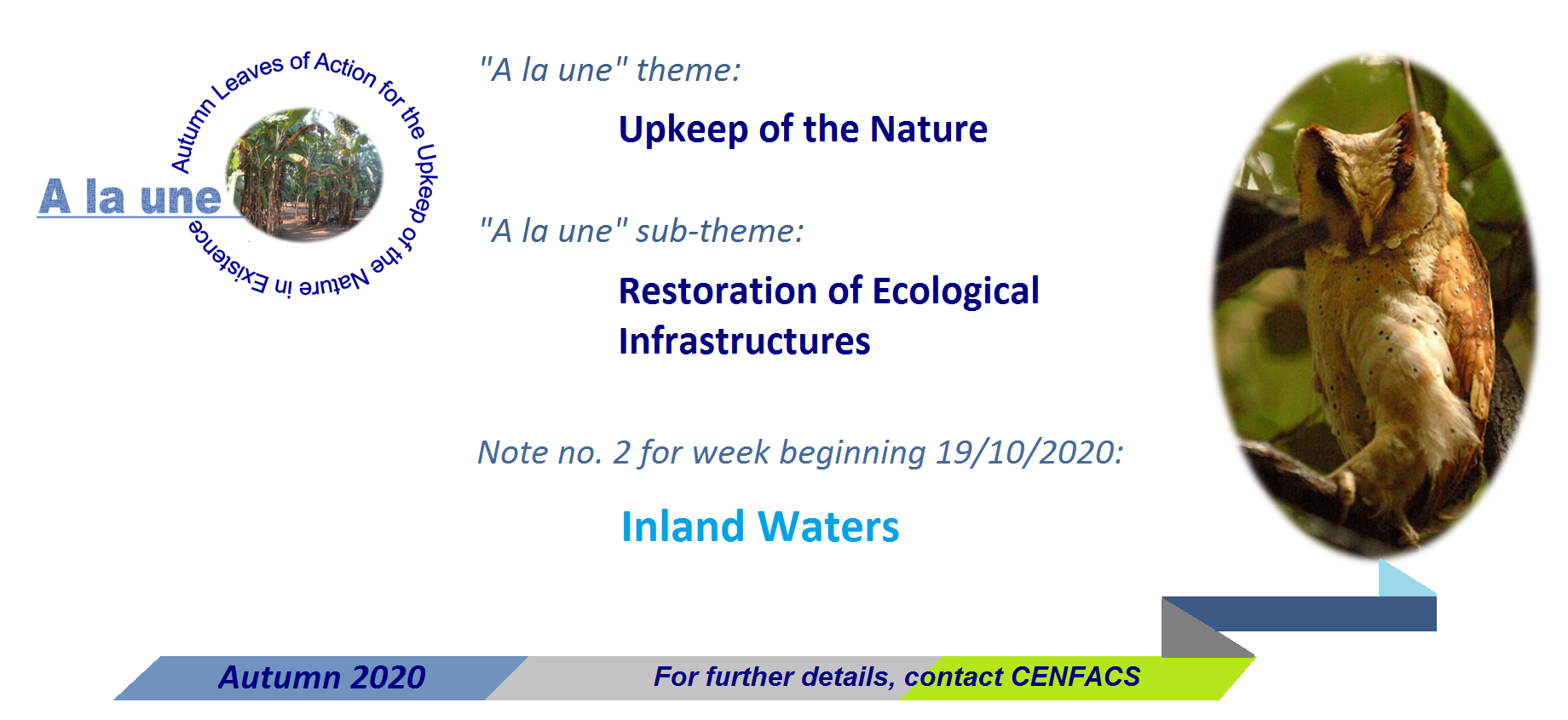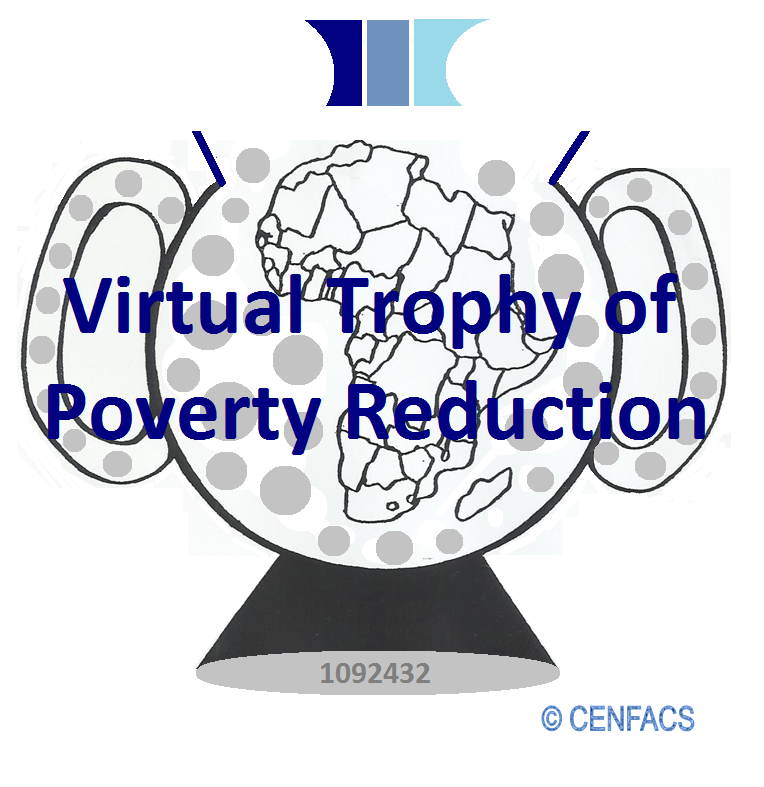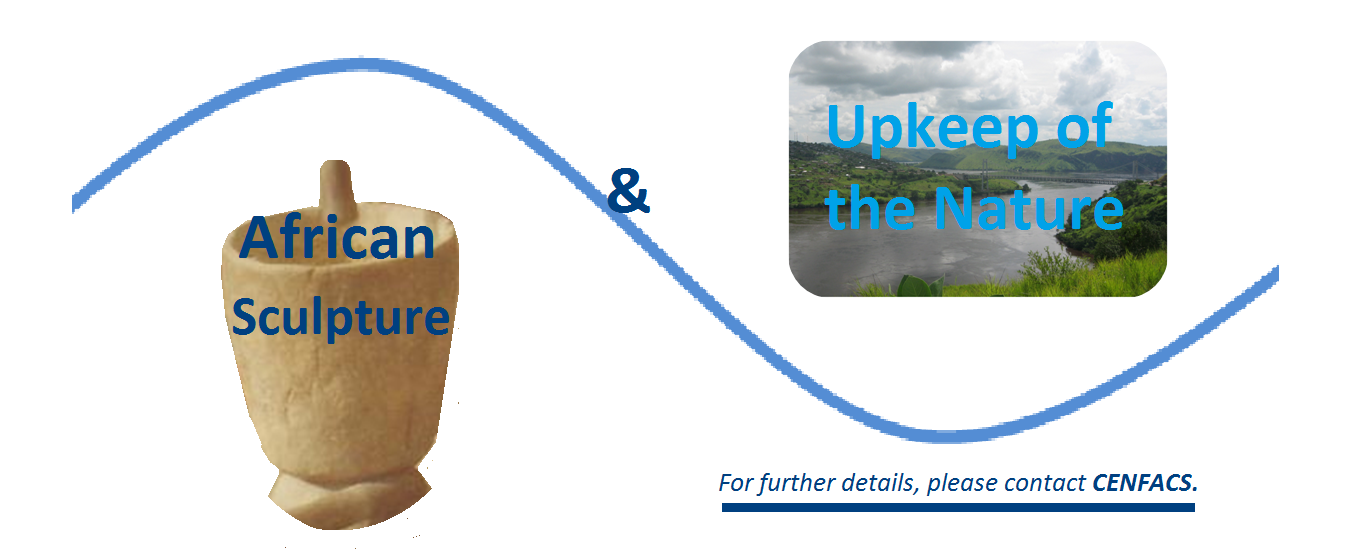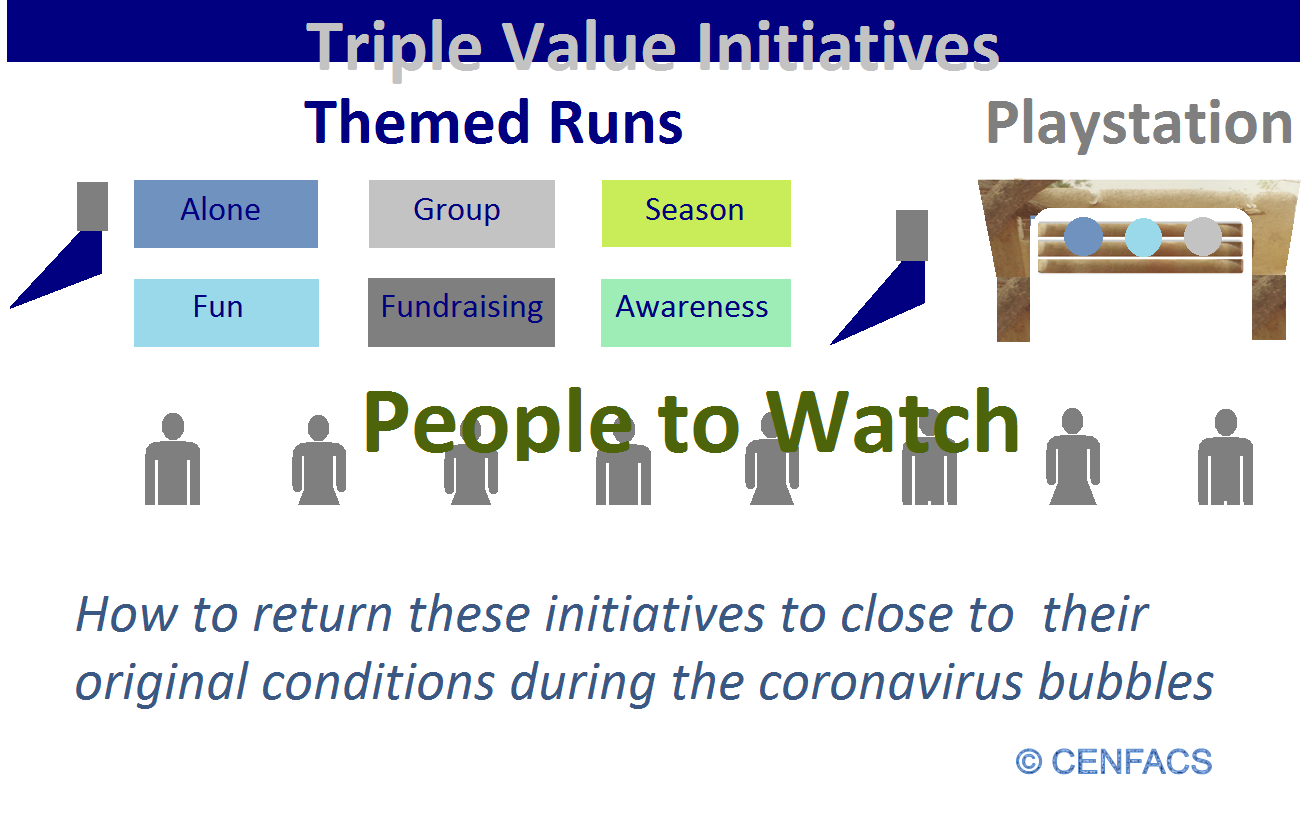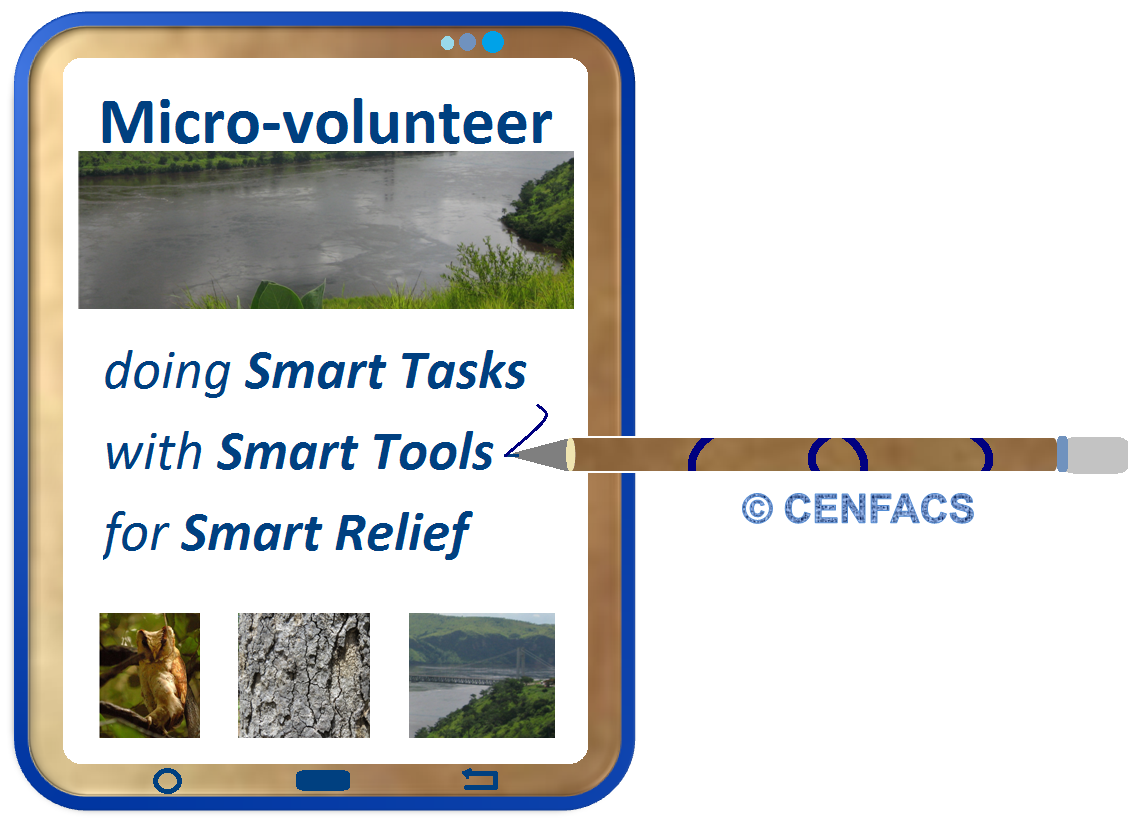Welcome to CENFACS’ Online Diary!
21 October 2020
Post No. 166
The Week’s Contents
• “A la une” (Autumn Leaves of Action for the Upkeep of the Nature in Existence) Themed Activities, Note No. 2 – In Focus for Week Beginning 19/10/2020: Restoration of Inland Waters
• Sustainable Trajectories for the Nature
• Coronavirus Rehabilitation Programme for African Organisations
… and much more!
Can you tell CENFACS who will win this trophy of the pandemic year?
Key Messages
• “A la une” (Autumn Leaves of Action for the Upkeep of the Nature in Existence) Themed Activities, Note No. 2 – In Focus for Week Beginning 19/10/2020: Restoration of Inland Waters
Inland Waters prolong the “Blue Spaces” theme we developed and campaigned for last month. As part of this extension and this October 2020 “A la une” Themed Activities, we are working on restoration of inland waters, that is the process of re-establishing inland waters (in Africa) to close to their original condition.
Restoring Inland Waters is indeed the rehabilitation of the structure and function of damaged inland waters. This restoration is itself part of the sub-theme of the Restoration of Ecological Infrastructures (in Africa) as explained last week.
For the purpose of the main theme of the Upkeep of the Nature, the Restoration Inland Waters will be approached from a socio-ecological point of view. Under the Main Development section of this post, we have provided further information about this second note and the said approach to it.
• Sustainable Trajectories for the Nature with…
Actions to Reduce and or Stop Rising Temperatures during the Post-coronavirus Recovery
Sustainable Trajectories for the Nature (STN), which is part of the “A la une” Campaign, is also an environmental campaign on its own. This is because its contents are intertwined with some of the aspects of the “A la une” Campaign.
Under the STN, we are looking at Sustainable Trajectories in terms of the following trajectories:
√ Temperature
√ Sea levels
√ Wildlife population
√ Greenhouse gas emissions during the post-coronavirus recovery
During the Spring and Summer lockdowns, there were some good results and news about the reduction of air pollution, electricity, transport use, industrial activity and noise in some big cities of the world including London and Kinshasa. Many confined places (in countries such as China) recorded low levels of energy demand and CO2 emissions.
However, do these good results suggest the decreasing pattern of temperatures in relation to the climate goal of reducing the global temperature to 1.5 degrees Celsius or it was just an exception due to the Covid-19 confinement?
Indeed, the Paris Agreement central aim is about strengthening the global response to the threat of climate change by keeping a global temperature rise this century well below 2 degrees Celsius above pre-industrial levels and to pursue efforts to limit the temperature increase even further to 1.5 degrees Celsius.
Our work under STN is about searching on actions taken so far to reduce rising temperatures by checking if we are moving towards a net-zero emissions world in the post-coronavirus recovery. In this respect, we are looking at the above trajectories (that is temperature, sea level, wildlife population and greenhouse gas emissions trajectories in terms of rising temperature) if they are moving in the way of the Upkeep of the Nature.
The above is the key message about the campaign for Sustainable Trajectories for the Nature. To enquire about it and or ta add your input, please do not hesitate to contact CENFACS.
• Coronavirus Rehabilitation Programme for African Organisations
In the process of rehabilitating lives and economies, one should not forget our Africa-based Sister Organisations (ASOs) which are tirelessly working to support those in most need at this perilous time of the coronavirus bubbles. To work with them, we have developed a coronavirus rehabilitation programme as part of the Rehabilitation Strategies phase of our Campaign for Resilience against the Coronavirus Pandemic (in short, the Covid-19 Campaign).
• • What is a Coronavirus Rehabilitation Programme for African Organisations (CRPAO)?
Like we did it with the Cube of Protection against the Coronavirus Pandemic, the CRPAO is a series of planned projects and activities to be undertaken with ASOs in order to reduce poverty and hardships induced by the coronavirus pandemic while supporting them in bringing back into good or better condition the services and activities they were offering in the pre-coronavirus period.
The programme, which is a follow up from the Coronavirus-related Organisational Relief Programme which we set in Spring 2020, is about exploring the possibility of developing new and improved services and activities to cope with the changing reality on the grounds while incorporating the health (Covid-19) element into the programme.
One can hope that through this programme and model of working together, ASOs will be able to return coronavirus-disturbed projects and activities to their original or renovated conditions so that they can save and preserve the lifeline of those in need.
• • Scope of the rehabilitation programme
As said earlier, CRPAO is part of the Rehabilitation Strategies phase of the Campaign for Resilience against the Coronavirus Pandemic (the Covid-19 Campaign) by CENFACS. We have two rehabilitation strategies: one with the community in the UK and the other with ASOs in Africa.
• • • Rehabilitation Strategy with the CENFACS Community
This level of rehabilitation is part of our Individual Capacity Development Programme where we are trying to work with those making our community to restore their capacities and capabilities damaged or lost because of the coronavirus outbreak and subsequent lockdowns. In this respect, rehabilitation is defined in accordance to the World Health Organisation (1) as
“A set of interventions needed when a person is experiencing or is likely to experience limitations in everyday functioning due to ageing or health condition, including chronic diseases or disorders, injuries or traumas”.
In the context of our rehabilitation strategy, these conditions are the legacies of the coronavirus in terms of its health and economic threats and effects.
• • • Rehabilitation Strategy with our ASOs
The phase 3 of the Covid-19 Campaign (that is Rehabilitation Strategies) is extended to ASOs so that they can maximise or optimise their potentials and restore their damaged or lost capacity (because of the coronavirus pandemic) and deliver again their services and activities while the pandemic lasts and after it.
There is more information about the CRPAO within CENFACS’ Covid-19 Hub for Poverty Reduction which is a portal that centralises all the work and data about Covid-19. For those who want to find more about this programme, please contact CENFACS.
Extra Messages
• African Sculpture and the Upkeep of the Nature
Our tasting of a slice of African history is still much on track this October 2020. This week, this tasting is happening through some learning about African Sculpture and the Upkeep of the Nature.
The slice tasting in the lead up to the two days (27 and 28 October 2020) of Making Memorable Difference Project with its focus on African Sculpture and Representation of African Historical Figures of the Pre-independence Era; is indeed a pre-heat activity.
The pre-heat activity about sculpture and nature links the history month and our nature campaign “A la une”. This link finds its essence as Africans draw resources from nature and environment in order to produce sculptural products. There could be an impact on nature in terms natural resources exploitation and extinction.
So, this pre-heat activity is meant to connect us to the main feature of the history month, that is African Sculptures and Representation of African Historical Figures of the Pre-independence Era (era before the 1960s).
For any enquiries and or queries about the pre-heat activity, please contact CENFACS.
• All year-round Projects (Triple Value Initiatives): Play, Run and Vote Projects in the Phase of Rehabilitation Strategies
The three components of our all-year round projects (that is Run, Play and Vote) are back this Autumn. As we are heading towards the end of the year 2020, one can hope progress has been made for these projects; records have been taken since these projects started in January 2020.
However, like our other projects Triple Value Initiatives (TVIs) have been disturbed by the current social and economic development in relation to the coronavirus bubbles. Lockdown pressed pause on our TVIs. This is despite the fact that we integrated the Covid-19 factor in them and made them Covid-19 secure.
As a result of the Covid-19 integrations into Triple Value Initiatives, we suggested to those who were interested to undertake some recreational activities to break out the vicious of the coronavirus pandemic and to stay active during the social distancing rules and general lockdown in Spring and Summer 2020.
As the Covid-19 bubbles continue, we are working on similar forms of exercises or activities to engage CENFACS’ audience and nurture the CENFACS Community by helping it, where we can, to take steps to return these initiatives to their original conditions. These new forms of exercises or activities will be done under the Phase of Rehabilitation Strategies of our Covid-19 Campaign and in the context of our Individual Capacity Development Programme. What does it mean for our Triple Value Initiatives (TVIs)?
It means that we have started the process of restoring them to their initial or original condition while still fighting the coronavirus and its far-reaching consequences. It also signifies we keep shadowing the coronavirus pandemic in the work of restoration.
The restoration process is a learning curve since we are trying to restore the normality in our TVIs while we have integrated the Covid-19 as a new normal. In doing so, we are making sure that the fight against the coronavirus which is not yet over finds a room in our TVIs.
Because of the unprecedented time we are in at the moment, the need to work together is even greater than ever before. For those who have their own rehabilitation strategies, it will be a good idea to share them (online or in-person) within the community.
Just remember, at the end of the process of All year-round Projects and by the end of the year, one should be ready to announce the 2020 Action-Results for either of the project: Run or Play or Vote.
The final Action-Results will consist of finding out and revealing the following for the pandemic year:
√ The Best African Countries of 2020 which best reduced poverty
√ The Best African Global Games Runners of 2020
√ The Best African Development and Poverty Relief Managers of 2020
If you have not yet thought about this finding or revelation, please start thinking now and have your say about it!
• Micro-Volunteer doing Smart Tasks with Smart Tools for Smart Relief
Last week, we provided you with No Direct Cash Donations as ways of adding value to our traditional ways of getting support. The coronavirus pandemic and its subsequent impacts have pushed us to go out of our way to innovate in increasingly using distance working technologies and means as physical or in-person activities were banned in order to protect the public health and keep the fight against the coronavirus in control.
This additional way of working and engaging with our audience and supporters has brought some opportunities. We shall continue to use distance working and online technologies in our campaigns to reach out to our supporters. As a result, we would like to enhance the use of micro-volunteering by doing smart tasks with smart tools (such as smart phones, tablets, video calling etc.) to re-engage with CENFACS audience and supporters.
Smart tasks are specific, measurable, achievable, realistic and time-bound tasks and activities to generate and increase support towards our good and deserving causes, which we badly need at this bubbling time of the coronavirus pandemic.
These tasks briefly include the following: prospecting potential supporters, running questionnaires, recruiting new supporters, engaging with supporters, sending and receiving messages from supporter, following the leads, etc.
To enable us to continue our work, we are asking to those who can, both individuals and organisations, to support us with smart tools to enhance our micro-voluntary work.
To support CENFACS with Smart Tools to Micro Volunteer doing Smart tasks to deliver Smart Relief, please contact CENFACS.
Main Development
• “A la une” (Autumn Leaves of Action for the Upkeep of the Nature in Existence) Themed Activities, Note No. 2 –
In Focus for Week Beginning 19/10/2020: Restoration of Inland Waters
The message through our second note of the “A la une” Campaign is about how we can help the Upkeep of the Nature through the Restoration of Ecological Infrastructures particularly Inland Water.
In order to get our message across, we are going to explain inland water, clarify the approach used, expand on inland water as ecological infrastructure and identify good examples of water restoration projects in Africa.
• • What is Inland Water?
Without getting into complex definition about inland water, let us simply argue that it is any water space that is inside land territory. In other words, inland water is an area of water does it not sea (e.g. lakes, canals, rivers, etc.) which is part of ecosystem infrastructures.
• • What is Restoration of Inland Water?
The restoration of inland water is the activity or act of re-establishing inland water (for example a river or canal or lake) to close to its original condition with the aim of improving the quality of water and resources it contains while protecting it from the adverse impacts of climate change.
The restoration of inland water is part of the United Nations Sustainable Development Goal 15 (2) which is about Life on land. The first target of this goal is stated as follows:
“By 2020, ensure the conservation, restoration and sustainable use of terrestrial and inland freshwater ecosystems and their services, in particular forests, wetlands, mountains and dry lands, in line with obligations under international agreements”.
For instance, in Africa the Lake Chad was damaged by drought (an adverse impact of climate change) and human insecurity in the Lake Chad Basin. Restoring the Lake Chad and its natural capacity in terms of resources it contained and the quantity and quality of water it had is still a matter of ecosystem infrastructure and poverty reduction until today for those living in and around the basin.
• • Approach to the Restoration of Inland Water
There are many approaches or ways of dealing with the restoration of water. In this campaign, inland water will be approached from the socio-ecological perspective, particularly in its function and ability to reduce poverty and economic hardships while providing a blend of other benefits in society, the African societies.
We are looking at the socio-ecological dynamics that lies in human exploitation of inland water which made many valuable natural species to disappear or diminish. We are as well dealing with the state of inland water infrastructure at this pressurised time of the coronavirus where many people are searching for safe inland water for drinking and cooking in many places in Africa.
• • Campaign Areas of Focus
As argued above, this note deals with the restoration of the function of inland water particularly its function to reduce poverty and hardships in water. Our campaign is for keeping drinking water safe and saving wildlife. As part of this campaign, we are dealing with the elements which impact the quality and quantity of inland water. Amongst them are pollution, population growth and climate change.
• • • Pollution
Inland water is polluted by sewage, animal waste, dissolved chemicals and fertilizers. Our campaign is against water pollution, but for the restoration of inland water infrastructure if damaged by chemicals dumping or any other forms of pollution.
• • • Population growth versus available inland water
Rivers, lakes and wells may not meet the growing needs of growing population like in Africa. Our campaign on this matter is about the protection of inland water infrastructure while equating water distribution with population pressure
• • • Climate change
It is said in the United Nations World Water Development Report 2020 (3) published by the UNESCO (United Nations Educational, Scientific and Cultural Organisation) that
“Impacts of climate variability on Africa’s water resources are already acute, as exemplified by the recent decrease in rainfall in Southern Africa” (p. 7)
“Such impacts will also increasingly interact with multiple non-climate-related drivers of water scarcity and water pollution such as growing population, economic development, and conflict and fragility, which are posing serious challenges for meeting not only the water targets but also the other development targets defined in the 2030 Agenda and the Africa Union’s Agenda 2063” (p. 132)
In response to the above impacts, our campaign is about mitigating and adapting to the climate change adversity while protecting inland water infrastructure from this adversity.
• • Inland Water Restoration Projects in Africa
Our campaign is looking at good examples of water damage restoration projects at local level in Africa. There are numerous examples about water restoration projects developed and run by our Africa-based Sister Organisations.
Those who are interested in these examples, they can let CENFACS know their interest. For example, water restoration infrastructure project for the Lake Chad is one of them.
For further details about this second note of “A la une” Campaign and the sub-theme of Restoration of Ecosystem Infrastructures, please contact CENFACS.
_______
(1) https://www.who.int/news-room/fact-sheets/detail/rehabilitation
(2) http://www.undp.org/content/undp/en/home/presscenter/pressreleases/2015/09/24/undp-welcomes-adoption-of-sustainable-development-goals-by-world-leaders.html
(3) UNESCO, 2020: the United Nations World Water Development Report 2020, WATER AND CLIMATE CHANGE (www.unwater.org)
________
Help CENFACS keep the Poverty Relief work going in 2020.
We do our work on a very small budget and on a voluntary basis. Making a donation will show us you value our work and support CENFACS’ work, which is currently offered as a free service.
One could consider a recurring donation to CENFACS in the future.
Donate to support CENFACS!
FOR ONLY £1, YOU CAN SUPPORT CENFACS AND CENFACS’ PROJECTS, JUST GO TO http://cenfacs.org.uk/supporting-us/
Thank you for visiting CENFACS website and reading this post.
Thank you as well to those who made or make comments about our weekly posts.
We look forward to receiving your regular visits and continuing support throughout 2020 and beyond.
With many thanks.
